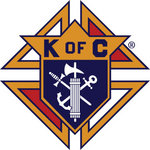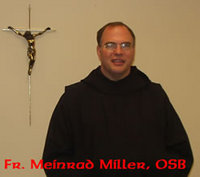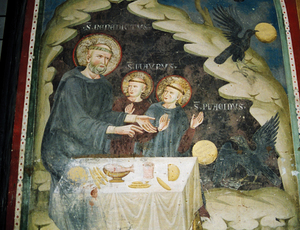Benedictine monks and sisters count on Knights of Columbus as collaborators
in building the kingdom of God
By Molly Mulqueen
At Benedictine monasteries throughout the United States, Knights of Columbus are
 working side by side with monks and sisters to build the kingdom of God. The ardent friendship between today's Knights and Benedictines parallels medieval times. Then, royal patrons such as kings, queens and knights welcomed the followers of St. Benedict as they established abbeys and other monastic centers throughout Europe.
working side by side with monks and sisters to build the kingdom of God. The ardent friendship between today's Knights and Benedictines parallels medieval times. Then, royal patrons such as kings, queens and knights welcomed the followers of St. Benedict as they established abbeys and other monastic centers throughout Europe.
The Benedictines are guided by St. Benedict's motto, "ora et labora" (Latin for "pray and work"), just as the Knights are guided by theirs, "In service to One. In service to all." Their similar charisms have allowed for fruitful collaborations on many landscapes: the deserts of Arizona, the banks of the Missouri River in Kansas, the Arkansas River valley, and sunny central Florida.
Helping with Harvest
In Tucson, Ariz., the friendship between Knights and the Benedictine Sisters of Perpetual Adoration began almost by accident. A little over a year ago, some observant Knights noticed one of the sisters struggling with a lawn mower.
"So may times we would see Sister Sophia out cutting the grass, and it didn't seem right," said Grand Knight Donatus Kelch of Regina Cleri Council 5133.
Now Kelch meets with the sisters every month to prioritize their maintenance needs. The 26 councils in the Tucson area have adopted the Benedictine monastery as a joint project. Many of the councils also sponsor an annual fundraiser to benefit the sisters.
"[The Knights] have repaired and painted the hand railings to the stairs and ramps leading up to the entrance of the chapel," said John Garcia, public relations director for the Arizona State Council and a member of Sts. Simon and Jude Cathedral Council 12708 in Phoenix. "They have repainted rooms within the facility, replaced furniture, and have done air-conditioner repairs, plumbing repairs and other maintenance projects."
But helping to harvest the sisters' orange crop is perhaps the most enjoyable project for many of the Knights. Last January, more than 20 Knights and their wives -- known as the "Orange Crew" -- picked and washed hundreds of oranges. They then fed the oranges through juicers, producing nearly 100 gallons of juice to freeze for the sisters' use throughout the year.
The sisters have shown their gratitude by inviting the Knights to a Mass of appreciation. According to District Deputy Douglas Cameron, "If you spend even ten minutes with them, you go away a better person. The prayers they offer for us more than thank us."
Fifty Years of Support
This fall, St. Benedict's Abbey in Atchison, Kan., will celebrate 50 years of support from the Knights at Benedictine College. Members of St. Benedict College Council 4708 have heartily embraced the "ora et labora" principle of Benedictine spirituality. This past year, the Knights split wood and shoveled snow at the abbey, and helped with vocations retreats and weekly holy hours.
"As time has gone on, we have fewer monks to carry on the Catholic mission of the college. The Knights of Columbus on campus have cooperated wonderfully with the monks to help promote Catholic identity," said Benedictine Father Meinrad Miller,
 subprior of St. Benedict's Abbey, the college chaplain and an active Knight.
subprior of St. Benedict's Abbey, the college chaplain and an active Knight.
Father Miller often recognizes alumni at neighboring parishes and at the annual Knights of Columbus state convention. "I am always impressed with the high level of participation of graduates from our college" he said.
"When I was in school [at Benedictine College], we were the top college council in the nation three of the four years I was here," said Benedictine College President Stephen D. Minnis, a member of Council 4708. "One of the things I am very proud of is that we have several Fourth Degree Knights who participate in special Masses. They led the procession when I was inaugurated as the president of my alma mater, and I'll never forget how proud I was of our Knights on that day."
The friendship between the Knights and the monks at St. Benedict's Abbey is mutual. "I really think that the monks have had a great influence on the Knights here to become holier men," said Dan Misener of Council 4708. "They have taught many of us the power and importance of prayer...and how to be true Catholic men in the society that we live in today."
Abbey 'Work Weeks'
The monks at Subiaco Abbey and Academy in Arkansas count on the Knights to help maintain their working farm and a boys' boarding and day prep school that serves about 175 students. Benedictine Brother Ephrem O'Bryan, public information coordinator for Subiaco Abbey and Academy, keeps a running list of the ways the Knights have helped.
"The Paris Knights [Logan County Council 3787] provide scholarships for the sons of Knights, contribute funds for the monks' education, help fund other scholarships for day students, help run a Squires circle [St. Benedict Circle 5073], contribute to the Abbey Health Center and prepare the noon meal for the annual 5th Grade Vocation Day," recalled Brother Ephrem.
Clarksville Council 5725 has likewise provided funds for the academy's scholarship program, as well as for the renovation of abbey living quarters, for health center equipment and for the Abbey Guest House.
Additionally, Arkansas Knights have organized a five-day work week every summer for the last six years. Knights from throughout the state tackle big projects, such as resurfacing tennis courts, building an irrigation system and adding sidewalks with wheelchair access. Work week volunteers are guests of the abbey and join the monks for Mass, meals, vespers and socializing. It has become an event that many Knights look forward to all year.
"We go up there three months in advance and talk with the abbot and the maintenance people about what needs to be done," explained A. J. Hambuchen of Father Dellert Council 4143 in Conway. "They never have come up with a project that we have not been able to do."
Most of the Knights who attend are retired professionals with contracting experience. Many bring their own materials and tools in an effort to cut costs further.
"It is wonderful for us to have Subiaco, and we show our appreciation by helping them out," Hambuchen said. "The monks thank us by praying for us and our families."
Rebuilding a Church
On Dec. 1, 2007, when the monks of St. Leo Abbey celebrated the blessing of a new abbot, Father Isaac Comacho, it was fitting that an honor guard of Fourth Degree Knights
 was part of the ceremony. Their presence was a testament to the enduring friendship between the Knights and the monks that spans several generations. The Benedictines have been in Saint Leo, Fla., since 1889, and Knights were first established in nearby San Antonio in 1914.
was part of the ceremony. Their presence was a testament to the enduring friendship between the Knights and the monks that spans several generations. The Benedictines have been in Saint Leo, Fla., since 1889, and Knights were first established in nearby San Antonio in 1914.
"We have seen the Knights develop in just about every parish in the area," said Benedictine Father James Hoge, a former K of C chaplain and faithful friar. "One of their principal works has always been to support and assist our schools. They have also always assisted with the charities in the area."
"The Knights in this part of Florida are a real community organization. They raise money to feed the poor and create recreational activities for kids," said Brother Stephen Freeman. "They have also helped us a great deal by defraying some of the costs of our Benedictine seminarians."
In addition, Knights host an annual golf tournament, the proceeds from which go to the restoration of the Church of the Holy Cross. The 60-year-old church is one of three buildings on the abbey campus named to the National Register of Historic Places. It is known for its 86-foot tower, Lombardic-Romanesque design and the crucifix that hangs above the altar, which was meticulously modeled after the figure of Christ on the Shroud of Turin.
"Twice a year, we invite [the Knights] to come for Mass and we have a day just for them. It is our way to thank them for being so supportive of the abbey," Brother Stephen said. It is simply one more part of the history that the Knights and Benedictines share.
Molly Mulqueen is a wife, mother and freelance writer for the Catholic press from Houston, Texas.
This article was published in Columbia magazine, August 2008. I am grateful to Alton Pelowski, managing editor of Columbia magazine, the monthly periodical of the Knights of Columbus, for allowing this republication.



Leave a comment